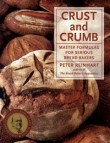FAQ #1, Sourdough Starters
This will be the first of a series of posts that address the most frequently asked questions that I get from our readers. I will just deal with one at a time, and will headline them FAQ with a number next to it as well as a word identifier, so this one will be FAQ #1, Sourdough Starters. That way, when someone wants to track one down in the Peter’s Blog section each question will be easy to find.
So yes, this one is about sourdough starters, one of the great mystery areas of bread baking. I will keep it short, as I have a much longer file that goes deeply into the subject and will send it to those who are serious about the matter, while not boring the rest of you here with the complicated stuff. This posting will be more like the headline news version. If you want the file, write to me at peter@pizzaquest.com to request it.
Just to clarify and get us all on the same page, sourdough starter is really another way of saying a natural leaven, composed of various wild yeast strains and also various bacteria stains that produce both lactic and acetic acid, all living in a medium made up of flour and water. The starter can be kept either in a wet, spongey form or in a firm, bread-dough-like form. In either instance, there is usually no salt in a wild yeast or sourdough starter (the salt gets added during the mixing of the final bread dough). The micro-organisms live in the flour mixture, which is replenished from time to time on a feeding schedule determined by the baker. These starters take the place of commercial yeast, or can also be used in conjunction with commercial yeast, to raise the dough. Because of all the complex acids produced by the bacterial fermentation, sourdough (aka wild yeast) breads contain an acidic flavor complexity not found in breads leavened by commercial yeast alone,
Instructions for how to make a sourdough starter from scratch are contained in the file referred to above. What I want to address here is one issue that I hear about a lot: why isn’t my starter bubbling away by the third or fourth day when I make it from scratch the way it’s supposed to, especially since it started bubbling on Day Two? Something has changed in flour, I believe, since I first started giving instructions fifteen years ago for how to make a starter from scratch. This is just a theory, based on some sleuthing done by a chemist friend of mine, Debbie Wink, who analyzed the microbiology of her starters under a microscope, but it seems to be proving itself: there is a lactic acid bacteria called Leuconostoc that seems more prevalent in grain these days and it has changed the way wild yeast grows in a starter. At first, it mimics yeast in that it produces carbon dioxide, much as yeast does, when it ferments the natural grain sugars in the dough mixture. It makes us think that the starter has come to life and that the wild yeast is growing and multiplying — but the yeast hasn’t multiplied. Wild yeast needs an acidic environment in order to flourish, and this is exactly what the bacteria provides. But Leuconostoc, while slowly producing acid, actually doesn’t like to live in it. So, while this bacteria, along with other bacteria present in the starter (mostly having come in with the flour, but probably some also some from the air), eats sugar and creates acid, while the wild yeast waits and waits until the Leuconostoc goes dormant, and then the yeast cells become active and multiply. As a result, what used to be about a five day process now takes as many as 7 to 10 days. The problem, though, is that if if you just let the starter sit and wait, some unfriendly bacteria can land on the surface and create molds. If you proceed to the next feeding cycle prematurely, before the starter starts to bubble and burp, it just sets it back another few days.
So, the best way to get through this middle, dormant phase is to stir or knead the starter (we call it a seed culture at this stage, prior to becoming a full-on starter) twice a day to prevent the invading bacteria from getting a foot-hold. It may take three or four days to finally wake up but eventually it will. By this time the Leuconostoc will go dormant and the other, more flavorful acid producing bacteria will thrive, as will the strains of wild yeast that provide the leavening for your bread. Once the seed culture come to life, you can resume feeding it as directed in the instructions to complete your sourdough “mother” starter.
Note: one trick that seems to shave a couple days off the process is to use pineapple juice (or even orange juice) on the first day when making the Day One seed culture. The acid from the juice gets things going in the right direction, but you still may run into a dormant period in the middle phase. Don’t give up on your starters, though; they will come to life if you remember to stir or knead them twice a day during the dormant phase.
Again, for more details, write to me at peter@pizzaquest.com and I’ll send the file, or you can read about it my books, Whole Grain Breads, and also in Artisan Breads Everyday. Those of you who have your own tricks for making a potent wild yeast starter, feel free to comment below and share your methods. Also, refer to our sourdough maven, Teresa Greenway’s website at www.northwestsourdough.com for all sorts of great recipes, info, and photos.
Recent Articles by Peter Reinhart
- “Tommy & Atticus” in Redondo Beach, CA. A Sourdough Success Story
- Howard Brownstein on Turnaround and Crisis Management
- Randy Clemens and Forest Farming in Uruguay — The Back to The Earth Movement is Back!
- It’s not too late to chase your dreams: “Pizza From the Heart” A New Book by Paulie and Mary Ann Gee
- Kyle Ahlgren on the Artisan Baking Center Online Classes (and a special offer)
- Multi-James Beard Nominee Cathy Whims of Portland’s Nostrana and her Brand New Book
Add Comment
You must be logged in to post a comment.










So how do we incorporate the sourdough starter into the pizza dough?
I tried my first starter a couple of weeks ago and it started of gangbusters. Then on day 3 it stalled completely. Started a new one a few days ago and same thing on day 4. After this mornings feeding it has done nothing. So I will just stir twice a day and see what happens.
Write to me at peter@pizzaquest.com and I’ll send you (and anyone else who sees this) a file I compiled on how to address this stalling tendency. The main thing is to not give up on your starter but, instead, if it stalls, stir it twice a day to prevent mold from forming on the surface, and give it a few extra days till it wakes up. I give more details in the file and in my most recent books about why, but the main thing is that it will come back to life.